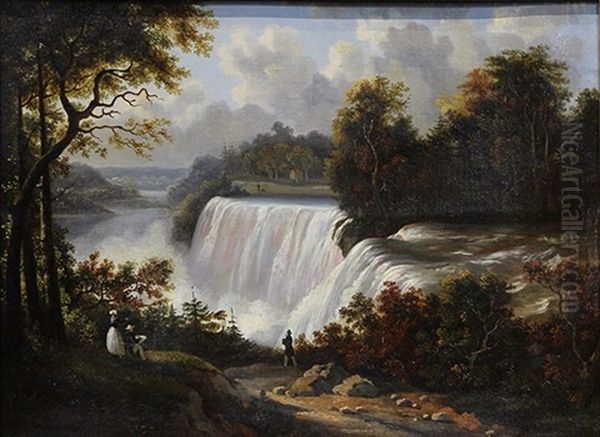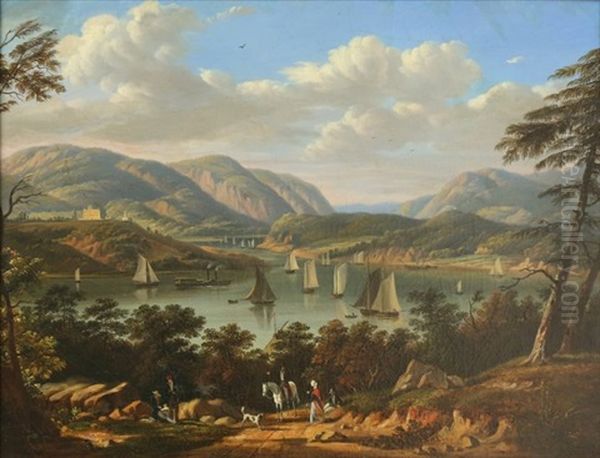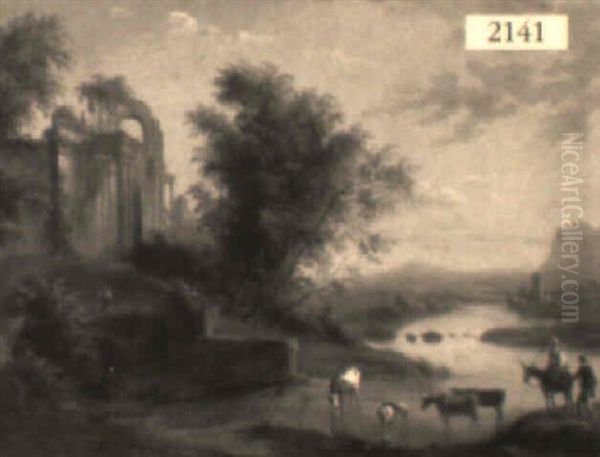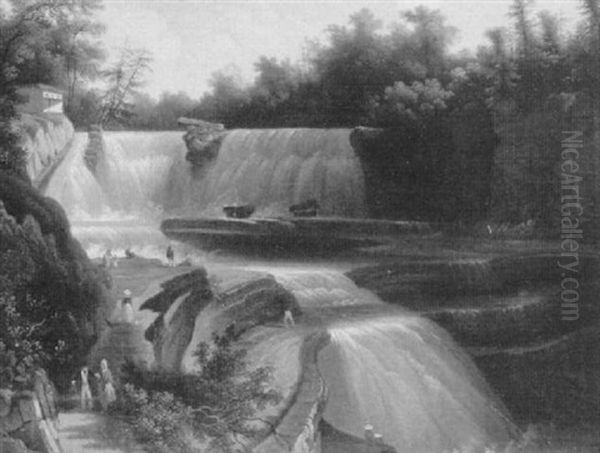Victor de Grailly (1804-1889) stands as a fascinating figure in 19th-century French art, a painter whose career bridged the waning influence of Neoclassicism and the burgeoning appeal of Romanticism. Born in Paris, he became renowned for his meticulous and often idyllic landscape paintings. While deeply rooted in French artistic traditions, a significant portion of his fame, particularly in the United States, derived from his captivating, albeit second-hand, depictions of American scenery. His work offers a unique window into the tastes of the era, the transatlantic exchange of imagery, and the enduring appeal of the picturesque.
Early Life and Artistic Formation in Paris
Born on January 29, 1804, in Paris, Victor de Grailly entered a world where artistic conventions were in flux. The dominant Neoclassical style, championed by artists like Jacques-Louis David, was beginning to cede ground to the emotional intensity and individualism of Romanticism, heralded by figures such as Théodore Géricault and Eugène Delacroix. It was in this environment that de Grailly sought his artistic education.
He became a pupil of Jean-Victor Bertin (1767-1842), a distinguished landscape painter in his own right. Bertin was a staunch advocate of the Neoclassical tradition in landscape, emphasizing clarity, idealized forms, and often incorporating historical or mythological figures into carefully composed natural settings. Bertin himself had been a student of Pierre-Henri de Valenciennes, a key figure in establishing the academic legitimacy of landscape painting in France. Bertin's studio was a significant training ground; notably, it was also where the celebrated Jean-Baptiste-Camille Corot received his early instruction, making Corot a contemporary of de Grailly under the same tutelage. This shared educational background provided both artists with a strong foundation in draughtsmanship and compositional structure, even as their paths would later diverge stylistically.
The Enduring Influence of Jean-Victor Bertin

Jean-Victor Bertin's influence on Victor de Grailly was profound, particularly in the early stages of his career. Bertin instilled in his students a respect for the principles of paysage historique (historical landscape), which involved creating idealized scenes often inspired by classical literature or mythology, meticulously composed and executed with a high degree of finish. While de Grailly would eventually embrace more Romantic and picturesque elements, the precision and clarity learned from Bertin remained a hallmark of his style.
Bertin's own works, such as "View of a Town in the Roman Campagna" or "Cicero Returning from Exile," exemplify the Neoclassical landscape ideal: balanced compositions, harmonious colors, and a sense of timeless order. De Grailly absorbed these lessons, evident in the careful arrangement of elements and the smooth application of paint in many of his European scenes. Even when depicting contemporary landscapes, a certain structural formality, a legacy of Bertin's teaching, can often be discerned. Other artists who passed through Bertin's studio, like Achille Etna Michallon (who won the first Prix de Rome for historical landscape), further underscore the importance of this Neoclassical lineage in French landscape painting of the period.
A Gradual Shift Towards Romanticism and the Picturesque
While de Grailly's foundations were Neoclassical, the artistic currents of the 19th century inevitably pulled him towards the burgeoning Romantic movement. Romanticism, with its emphasis on emotion, individualism, and the sublime power of nature, offered a different lens through which to view the landscape. Artists like Caspar David Friedrich in Germany or J.M.W. Turner in England were exploring the dramatic and awe-inspiring aspects of the natural world.
De Grailly's engagement with Romanticism was perhaps more tempered, often manifesting as a heightened appreciation for the picturesque – charming, irregular, and evocative scenes rather than the overtly dramatic or sublime. He frequently visited and painted in the Forest of Fontainebleau, a favored haunt of artists who would later form the Barbizon School. Here, he would have encountered painters like Corot again, as well as Théodore Rousseau, Charles-François Daubigny, and Narcisse Virgilio Díaz de la Peña, all of whom were pioneering a more direct and naturalistic approach to landscape painting, working en plein air (outdoors) to capture the fleeting effects of light and atmosphere. While de Grailly may not have fully adopted the Barbizon ethos, the exposure to their work and the shared environment likely encouraged a softening of his Neoclassical precision and a greater interest in capturing specific moods and atmospheric qualities.
The Allure of America: A Transatlantic Vision

One of the most distinctive aspects of Victor de Grailly's oeuvre is his extensive series of American landscapes. Intriguingly, there is no definitive evidence that de Grailly ever set foot on American soil. Instead, his American views were largely inspired by and often directly copied or adapted from engravings found in popular illustrated books of the time. The most significant source was William Henry Bartlett's "American Scenery; or, Land, Lake, and River Illustrations of Transatlantic Nature," published in London in 1840 with text by Nathaniel Parker Willis.
Bartlett (1809-1854) was a British artist renowned for his topographical drawings, which were widely disseminated through engravings. "American Scenery" featured numerous views of the Hudson River Valley, Niagara Falls, New England towns, and other notable American landmarks. These prints provided de Grailly with a rich visual vocabulary of the New World. He skillfully translated these monochrome engravings into vibrant oil paintings, often imbuing them with his characteristic bright palette, clear skies, and charming anecdotal details like figures strolling or boating. This practice was not uncommon at the time; the demand for views of distant lands was high, and artists often relied on prints and other secondary sources. What set de Grailly apart was the sheer volume and popularity of his American scenes.
His depictions of the Hudson River, West Point, various New England towns, and even views of Washington D.C., resonated deeply with both European and American audiences. For Europeans, these paintings offered a romanticized glimpse into the burgeoning American nation and its famed natural beauty. For Americans, particularly those who couldn't afford original works by Hudson River School painters like Thomas Cole or Asher B. Durand, de Grailly's more affordable and charming canvases provided a desirable way to bring images of their homeland into their homes.
Signature Style and Artistic Techniques
Victor de Grailly developed a recognizable artistic style characterized by several key features. His palette was generally bright and optimistic, with clear, often azure, skies and well-defined, fluffy clouds. He had a particular skill in rendering foliage with a delicate touch, and his depiction of water was typically calm and reflective, enhancing the serenity of his scenes.
A notable characteristic was his use of high-lighting, particularly on figures' clothing and architectural elements, which added a crispness and vibrancy to his compositions. His figures, though often small in scale, were rendered with care, adding life and a narrative element to the landscapes. They are typically engaged in leisurely pursuits – strolling, conversing, fishing, or boating – contributing to the overall picturesque and idyllic mood of his works.

Interestingly, de Grailly did not always sign his paintings. However, his distinctive style – the combination of French academic polish with a slightly naive charm, the specific color choices, and the characteristic rendering of figures and landscape elements – often makes his unsigned works attributable. His canvases were typically of modest to medium size, suitable for the domestic interiors of the burgeoning middle class that formed a significant part of his market.
Notable Works and Their Subjects
Victor de Grailly's output was prolific, encompassing both European and American subjects. Among his European scenes, works like Lake Sèvres (Lac de Sèvres) and views around Paris, such as Cape Clignancourt, showcase his early style, reflecting the influence of Bertin and the French landscape tradition. These paintings often depict tranquil, well-ordered scenes, bathed in a gentle light. He also painted views in other parts of France and potentially Switzerland, always with an eye for picturesque detail.
His American scenes, however, garnered him the most widespread recognition, especially posthumously. Eastport and Passamaquoddy Bay, Maine, a version of which hangs in the White House, is a prime example. Based on a Bartlett engraving, it captures the bustling harbor and scenic coastline with de Grailly's characteristic clarity and charm. Similarly, his various views of the Hudson River, such as scenes near West Point or depictions of river towns, were highly popular. Niagara Falls, another subject borrowed from Bartlett, allowed him to tackle a more sublime and powerful natural wonder, though often rendered with a picturesque rather than an overwhelmingly dramatic sensibility.
A painting titled Early View of the Capitol, held by the U.S. Department of State, demonstrates his engagement with iconic American landmarks. These works, while not based on direct observation, successfully captured the spirit and visual appeal of the American landscape as it was perceived and desired by audiences of the time. He also painted generic American river and valley scenes, often populated with figures in period dress, which appealed to a romanticized vision of American life.
Reception, Popularity, and Exhibitions
Victor de Grailly achieved considerable success during his lifetime. He regularly exhibited at the prestigious Paris Salon from 1833 until at least the 1870s, a testament to his standing within the French art establishment. The Salon was the primary venue for artists to showcase their work and gain recognition, and de Grailly's consistent participation indicates a sustained level of critical and popular acceptance in his home country.

His American scenes found a particularly receptive market in the United States. American art dealers and importers recognized the appeal of his charming, well-executed, and relatively affordable paintings. They were sold in cities like New York, Boston, Philadelphia, and even further south in Charleston and Baltimore. For many middle-class American families, a de Grailly painting offered an accessible way to own an "original oil painting" depicting a familiar or aspirational American view, often with the added cachet of being by a European artist.
The popularity of his work was such that it is believed many copies and variations, some by his own hand and others by followers or imitators, circulated in the market. This sometimes makes definitive attribution challenging but also speaks to the widespread demand for his particular style of landscape. His paintings entered numerous private collections and, over time, found their way into public institutions, recognized for their historical and artistic value as representations of 19th-century taste and the transatlantic visual culture.
De Grailly and His Contemporaries: A Comparative Perspective
Placing Victor de Grailly within the context of his contemporaries helps to illuminate his unique position. As mentioned, his training alongside Jean-Baptiste-Camille Corot under Bertin provides an interesting point of comparison. While Corot evolved into a leading figure of the Barbizon School and a precursor to Impressionism, known for his poetic and atmospheric landscapes, de Grailly retained a more precise and detailed approach, albeit infused with Romantic charm.
His American scenes can be contrasted with the work of the Hudson River School painters. Artists like Thomas Cole, Asher B. Durand, Frederic Edwin Church, and Albert Bierstadt (though the latter's grand Western scenes came slightly later) approached the American landscape with a sense of national pride and often a desire to convey its sublime grandeur and spiritual significance. De Grailly's American views, filtered through Bartlett's engravings and his own European sensibility, were generally more picturesque and less overtly nationalistic or philosophical, though they shared a common appreciation for the beauty of the American continent. His work was perhaps closer in spirit to that of other European artists who depicted America, or to the more topographically inclined members of the early Hudson River School.
In France, his landscape work can be seen alongside that of other artists who navigated the transition from Neoclassicism to Romanticism, such as Paul Huet, who was a more overt Romantic, or Prosper Marilhat, known for his Orientalist landscapes. De Grailly's adherence to a clear, descriptive style, even when depicting exotic (to him) American locales, set him somewhat apart from the more painterly or emotionally charged approaches of some of his Romantic contemporaries. He carved out a niche that appealed to a broad audience seeking pleasant, well-crafted, and evocative landscape paintings.
Legacy and Enduring Appeal
Victor de Grailly passed away in Paris in 1889. His legacy is multifaceted. Artistically, he represents a competent and appealing practitioner of 19th-century landscape painting, skillfully blending elements of his Neoclassical training with the picturesque sensibilities of the Romantic era. His European scenes are fine examples of French landscape tradition, while his American views occupy a unique niche in the history of American art collecting and visual culture.
The phenomenon of his American scenes – painted by a Frenchman who likely never visited the continent, based on British engravings – speaks volumes about the interconnectedness of the 19th-century art world and the power of printed images to shape perceptions of distant places. These works are now valued not only for their aesthetic qualities but also as historical documents, reflecting what 19th-century audiences wanted to see and how they imagined the American landscape.
His paintings continue to be appreciated by collectors and art enthusiasts. They appear regularly at auctions and are held in numerous museum collections, including the White House Historical Association, the New-York Historical Society, and various regional museums across the United States and Europe. The enduring appeal of his work lies in its charm, its meticulous execution, and the fascinating story of its creation, offering a picturesque journey through the landscapes of both the Old World and the New, as seen through the eyes of a talented Parisian artist. His contribution, particularly in popularizing American scenery through a European lens, remains a notable chapter in 19th-century art history.
Conclusion: A Bridge Between Worlds
Victor de Grailly's career is a testament to an artist who successfully navigated the evolving artistic landscape of the 19th century. From his Neoclassical foundations under Jean-Victor Bertin to his engagement with Romanticism and his unique venture into depicting American scenery via the engravings of William Henry Bartlett, de Grailly crafted a body of work that appealed to a wide international audience. His paintings, characterized by their clarity, bright palettes, and charming details, offer a delightful glimpse into the past. He remains a significant figure for his role in the transatlantic exchange of landscape imagery, demonstrating how art could transcend geographical boundaries and connect diverse cultures through the shared appreciation of natural beauty, even if that beauty was sometimes viewed through an intermediary lens. His works continue to enchant, serving as a colorful bridge between the artistic traditions of France and the burgeoning landscapes of a young American nation.